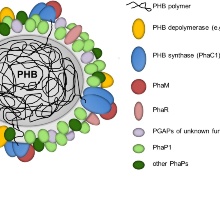Biopolymers
- Polyhydroxybutyric acid (PHB) and related polyhydroxyalkanoates (PHAs) are synthesised by many bacteria as storage materials in the form of PHA granules. PHAs are so-called "bioplastics" and are considered environmentally friendly alternatives to conventional crude oil-based plastics due to their biodegradability to H2O and CO2 and synthesis from renewable resources. PHA granules, with their complex surface structure of diverse proteins, represent small functional units (organelles) for which we have coined the term "carbonosomes". In our group we investigate the proteins involved in the subcellular formation of PHB/PHA granules and their individual functions.
- Polyphosphate (PolyP) is an inorganic biopolymer that occurs in all organisms and is therefore of fundamental importance. PolyP granules are complex structures (polyphosphatosomes) consisting of a polyP core and proteins bound to it (e.g. polyP kinases, phosines, etc.). We investigate the structure, formation and specific functions of polyP granules using molecular biology methods and life-imaging techniques in Agrobacterium tumefaciens and Ralstonia eutropha as model organisms.
- Polyisoprene (rubber). We focus on how rubber (car tyres!) is attacked and ultimately degraded (mineralised) by microbial enzymes. In recent years, we have discovered a novel haem-containing dioxygenase (Rubber Oxygenase RoxA) and recently elucidated its structure. We are currently investigating the oxidative reaction mechanism using biochemical, biophysical and molecular biological methods.
Our research fields:
Polyphosphate (PolyP) is an inorganic biopolymer that occurs in all organisms and is therefore of fundamental importance. PolyP granules are complex structures (polyphosphatosomes) consisting of a polyP core and proteins bound to it (e.g. polyP kinases, phosins, etc.). We investigate the structure, formation and specific functions of polyP granules using molecular biological methods and life-imaging techniques in Agrobacterium tumefaciens and Ralstonia eutropha as model organisms.
- Production of bioplastics from paper waste
Polyhydroxybutyric acids (PHB) and related polyhydroxyalkanoates (PHAs) are synthesised by many bacteria as storage substances in the form of PHA granules. PHAs are so-called "bioplastics" and are considered environmentally friendly alternatives to conventional crude oil-based plastics due to their biodegradability to H2O and CO2 and synthesis from renewable raw materials. With their complex surface structure consisting of various proteins, PHA granules represent small functional units (organelles) for which we have coined the term "carbonosomes". In our working group, we investigate the proteins involved in the subcellular formation of PHB/PHA granules and their individual functions. In particular, we use molecular biological methods and life imaging techniques.
Polyisoprene (caoutchouc, rubber). The main question here is how rubber (car tyres!) is attacked by microbial enzymes and ultimately degraded (mineralised). In recent years, we have discovered a novel haem-containing dioxygenase (rubber oxygenase RoxA) and recently elucidated its structure. We are currently investigating the oxidative reaction mechanism using biochemical, biophysical and molecular biological methods.
- Metabolism of citronellol and other methyl-branched compounds
- the topic has been closed since 2014
Contact



